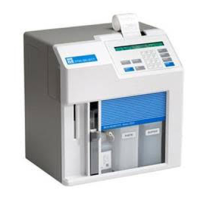4-4
Calibration Method (2-CalMethod).
In most chemistry setups, you will select “One Station”,
and the calibration station # will be “Station #1” (Calibration Well). However, you have options
to configure this in other ways.
»
Select One Station, but assign Cal Station #2. Station #2 is the Test Tube Holder
Station. For example, you may place a 500 mg/L dextrose solution in a test tube and
calibrate in this manner. If you choose this option, the sampling position is normally
Station #3 (Manual Station). With accessories, Station #4 (Turntable), or Station #5
(Monitor) may be used.
»
If you are running a dual chemistry where a potential interference is involved, you may
select “Two Station”. You will then be prompted to assign calibration stations for both
black and white probes. For example, you could install a sucrose membrane on one
probe and a dextrose membrane on the second probe. You could place sucrose
calibrator in the test tube position (#2) and dextrose at the Cal Well (#1). In this setup,
the instrument is programmed to measure the “dextrose reading” at the sucrose
membrane and automatically subtract it.
Black Probe Parameter (3-Black).
In this menu you choose parameters that correspond to the
chemistry of interest at the Black Probe. Be certain that you install the correct enzyme
membrane type. The selections include:
»
Chemistry (10 selections, plus “none”)
»
Unit of Concentration (g/L, mg/L, mmol/L, %(w/v))
»
Calibration value (must correlate to units chosen)
»
End Point (basically, the reaction time in the sample chamber)
For most standard applications, recommended parameter settings are outlined below under each
chemistry setup.
White Probe Parameter (4-White).
In this menu, you choose parameters that correspond to
the chemistry of interest at the White Probe. Be certain that you install the correct enzyme
membrane type. The selections include:
»
Chemistry (10 selections, plus “none”)
»
Unit of Concentration (g/L, mg/L, mmol/L, %(w/v))
»
Calibration value (must correlate to units chosen)
»
End Point (basically, the reaction time in the sample chamber)
For most standard applications, recommended parameter settings are outlined below under each
chemistry setup.

